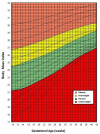Comparison of Three Gestational Weight Gain Guidelines Under Use in Latin America
- PMID: 34722425
- PMCID: PMC8550449
- DOI: 10.3389/fped.2021.744760
Comparison of Three Gestational Weight Gain Guidelines Under Use in Latin America
Abstract
Presently, three guidelines are used in Latin America to assess adequacy of maternal body mass index (BMI) during pregnancy: (1) the chart proposed by the Institute of Medicine of the United States (IOM), (2) the Rosso-Mardones Chart (RM), and (3) a modified RM chart proposed by Atalah et al. (AEA). The aim of the present review was to explore available information on the sensitivity, specificity, and both positive (PPV) and negative predictive values (NPV) of these charts to detect women at risk of delivering babies with the following signs of abnormal fetal growth: (a) length at birth (BL) <50 cm; (b) birth weight (BW) <3,000 g; and (c) BW ≥ 4,000 or 4,250 g. Data from studies conducted in large samples of Chilean and Uruguayan women indicate that the RM chart has the greatest sensitivity to identify at risk cases. However, predictive values were similar for the three charts. Thus, the use of the RM chart should be preferred. The main limitation for using the IOM weight gain recommendations in Latin American women stems from the fact that their average height is approximately 20 cm lower than US women.
Keywords: Latin America; gain; gestational; guidelines; weight.
Copyright © 2021 Mardones, Rosso, Erazo and Farías.
Conflict of interest statement
The authors declare that the research was conducted in the absence of any commercial or financial relationships that could be construed as a potential conflict of interest.
Similar articles
-
Pregnancy outcomes and the use of two standards to assess adequacy of maternal body mass index in early gestation.J Dev Orig Health Dis. 2016 Feb;7(1):83-9. doi: 10.1017/S204017441500714X. Epub 2015 Sep 9. J Dev Orig Health Dis. 2016. PMID: 26349587 Clinical Trial.
-
[Diagnostic accuracy of five gestational references to predict insufficient birth weight].Biomedica. 2007 Mar;27(1):42-55. Epub 2007 May 31. Biomedica. 2007. PMID: 17546223 Spanish.
-
Maternal pre-pregnancy body mass index, gestational weight gain influence birth weight.Women Birth. 2018 Feb;31(1):e20-e25. doi: 10.1016/j.wombi.2017.06.003. Epub 2017 Jul 14. Women Birth. 2018. PMID: 28716548
-
Weight gain during pregnancy: A narrative review on the recent evidences.Diabetes Res Clin Pract. 2022 Jun;188:109913. doi: 10.1016/j.diabres.2022.109913. Epub 2022 May 11. Diabetes Res Clin Pract. 2022. PMID: 35568262 Review.
-
Outcomes of maternal weight gain.Evid Rep Technol Assess (Full Rep). 2008 May;(168):1-223. Evid Rep Technol Assess (Full Rep). 2008. PMID: 18620471 Free PMC article. Review.
Cited by
-
Women's experience of body weight management during and post-pregnancy: a mixed methods approach.BMC Pregnancy Childbirth. 2024 Dec 19;24(1):823. doi: 10.1186/s12884-024-07033-6. BMC Pregnancy Childbirth. 2024. PMID: 39702168 Free PMC article.
-
Analysis and Comparison of Early Childhood Nutritional Outcomes Among Offspring of Chinese Women Under the Chinese 2021 and US 2009 Gestational Weight Gain Guidelines.JAMA Netw Open. 2022 Sep 1;5(9):e2233250. doi: 10.1001/jamanetworkopen.2022.33250. JAMA Netw Open. 2022. PMID: 36149650 Free PMC article.
-
Maternal weight latent trajectories and associations with adverse pregnancy outcomes using a smoothing mixture model.Sci Rep. 2023 Jun 2;13(1):9011. doi: 10.1038/s41598-023-36312-z. Sci Rep. 2023. PMID: 37268823 Free PMC article.
-
Nutritional status and factors associated with gestational weight gain in the city of São Paulo, 2012 to 2020: a retrospective cohort study.BMC Pregnancy Childbirth. 2024 Nov 13;24(1):746. doi: 10.1186/s12884-024-06955-5. BMC Pregnancy Childbirth. 2024. PMID: 39538141 Free PMC article.
-
Energy intake and physical activity over the course of pregnancy and gestational weight gain: a systematic review and dose-response meta-analysis of data from randomized controlled lifestyle intervention trials.Nutr J. 2025 Aug 7;24(1):123. doi: 10.1186/s12937-025-01182-w. Nutr J. 2025. PMID: 40775715 Free PMC article.
References
-
- Gluckman P, Hanson M, Seng CY, Bardsley A. Pre-conception maternal body composition and gestational weight gain. In: Gluckman P, Hanson M, Seng CY. editors. Nutrition and Lifestyle for Pregnancy and Breastfeeding. Oxford: Oxford University Press; (2014). p.216–20.
-
- Ministerio de Salud [Ministry of Health], Chile . Encuesta Nacional de Salud 2016-17 [National Health Survey 2016-2017]. (2017). Available online at: https://www.minsal.cl/wp-content/uploads/2017/11/ENS-2016-17_PRIMEROS-RE... (accessed August 30, 2021).
-
- Organization for Economic Co-operation and Development (OECD) . Obesity Update. (2014). Available online at: www.oecd.org/health/Obesity-Update-2014.pdf (accessed August 30, 2021).
Publication types
LinkOut - more resources
Full Text Sources


